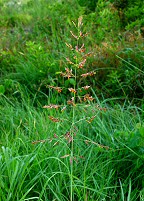Johnsongrass
Scientific name:
Sorghum halepense

Photo courtesy of Dan Tenaglia
Missouriplants.com
Habitat
Open, disturbed, and cultivated fields
Affected crops
Corn, cotton, grain sorghum, soybean, legumes, and many other agricultural crops
Distribution
Worldwide
Description
The stem is stout, erect, and smooth. The leaf is rolled in the bud, bright-green, and has a prominent white midrib down the leaf blade. The flower head is open, purplish, and has plenty of whorls of branches that are pyramid-shaped (the lower branches are longer than
the upper ones). The weed is propagated by seeds and rhizomes (rootstocks). It forms an intensive rooting system of creeping, stout, and cream-colored rhizomes with orange scales. A single plant can produce more than 80,000 seeds and 275 feet of rhizomes in one growing season.
Effect and impact
The intensive rooting system of Johnsongrass is the reason for the difficulty to control it once it invades agricultural crops. The decaying rhizomes release chemicals that prevent the growth of other plants. It is the alternate hosts for several crop pests such as diseases, nematodes, and insects and mites.
Studies show that the weed is found to be resistant to Imazethapyr, Nicosulfuron Fenoxaprop-p-ethyl, Fluazifop-p-butyl, Quizalofop-p-ethyl, Pendimethalin, Sethoxydim on corn, cotton, and soybean fields and croplands in some states of USA (Weed Science, 2005).
Methods of control
- Practice intensive tillage (cultivation)
to break the rhizomes and weaken the plants by thorough plowing and harrowing during land preparation. Avoid moderate tillage for this will allow the rhizomes to grow. Cutting the rhizomes into small pieces (less than 5 cm in length) makes them dry faster. Dried rhizomes (by 20% of their original weight) lose their ability to grow (Graham; Johnson, 2004).
- In orchards, regular cutting of the leaves deprives the rhizomes of food reserves and further limits its reproduction. Burning is not an option because fire encourages the re-growth of the rhizomes.
- Always control the weed by hoeing before it establishes and spreads on your entire farm.
- Regular field monitoring.

